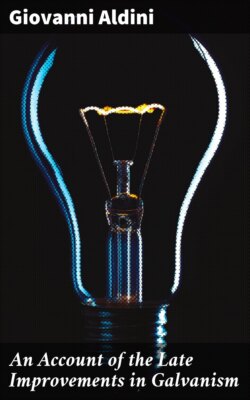| PART I. |
| PAGE |
| OF THE NATURE AND GENERAL PROPERTIES OF GALVANISM. |
| Proposition I. Muscular contractions are excited by the development of a fluid in the animal machine, which is conducted from the nerves to the muscles without the concurrence or action of metals | 3 |
| Prop. II. The Galvanism excited, in the preceding experiments, is not owing to the communication nor to the transfusion of the general electricity, but to an electricity peculiar to animals, which acts a very distinguished part in the animal economy | 6 |
| Prop. III. Galvanism develops itself in a powerful manner, independently of metals, by means of the human animal machine | 8 |
| Prop. IV. Muscular contractions can be excited, under certain conditions, without establishing a continued arc from the nerves to the muscles | 11 |
| Prop. V. The effects of Galvanism, in the preceding experiments, do not depend on the action of any stimulant, which occurs in performing the experiments, and ought not to be confounded with the effects of that action | 12 |
| Prop. VI. Galvanism is excited in the animal machine without any intermediate body, and merely by the application of the nerves to the muscles | 14 |
| Prop. VII. The heterogeneity of metals contributes, in a great degree, to excite muscular contractions with more facility, but is not absolutely necessary to their production | 19 |
| Prop. VIII. The Leyden flask, the Voltaic pile, and animal substances, have the faculty of absorbing principles from the atmospheric air in an insulated plenum | 21 |
| Prop. IX. Flame prevents the action of the Leyden flask, as well as that of the pile, and also muscular contractions | 27 |
| Prop. X. Certain fluids, applied to the whole surface of the pile, or of animal parts, do not prevent the action of Galvanism | 29 |
| Prop. XI. Mere electrization, by means of the common kinds of apparatus, does not increase the action of Galvanism | 32 |
| Prop. XII. The Galvanic action is increased by employing as part of the arc the apparatus of Volta, or the electrified Leyden flask | 34 |
| Prop. XIII. Galvanism, in animals and in the pile, traverses large spaces with the same rapidity as the electric fluid | 36 |
| Prop. XIV. The muscular contractions, which, according to the observations of Galvani, are produced by an electric atmosphere whether natural or artificial, correspond entirely with those produced by the pile, or by similar kinds of apparatus | 37 |
| Prop. XV. Opium, cinchona, and other stimulants of a similar kind, which exercise a powerful action on the animal machine, contribute also to excite the action of the pile | 41 |
| Prop. XVI. If the general relation between Galvanism and electricity be examined, such a correspondence will be found between them, as tends to confirm the analogy already stated | 44 |
| Prop. XVII. The hypothesis of an animal pile, analogous to that formed artificially, seems well calculated to explain the sensations and contractions in the animal machine | 47 |
| PART THE SECOND. |
| ON THE INFLUENCE WHICH GALVANISM HAS ON THE VITAL POWERS | 53 |
| Section I. Galvanism applied to various quadrupeds, birds, and other warm-blooded animals | 54 |
| Section II. Experiments made on human bodies after death | 67 |
| PART THE THIRD. |
| ON THE POWER OF GALVANISM AS APPLIED TO MEDICINE | 97 |
| Sect. I. Advantages which the medical administration of Galvanism has over that of common electricity | 99 |
| Sect. II. Application of Galvanism to the organs of hearing and of sight | 101 |
| Sect. III. Application of Galvanism in cases of asphyxia and drowning | 110 |
| Sect. IV. Galvanism applied to the cure of melancholy madness | 113 |
| Sect. V. General reflections on the action and influence which Galvanism, considered in a medical point of view, exercises on the animal œconomy | 123 |
| Dissertation on animal electricity, read in the Institute of Bologna in the year 1793 | 133 |
| Second Dissertation on animal electricity, read in the Institute of Bologna in the year 1794 | 155 |
| Conclusion | 186 |
| APPENDIX | 189 |
| No. I. An account of the experiments performed, by J. Aldini, on the body of a malefactor executed at Newgate Jan. 17, 1803 | ib. |
| No. II. Report presented to the Class of the Exact Sciences of the Academy of Turin, 15th August 1802, in regard to the Galvanic experiments made by C. Vassali-Eandi, Giulio, and Rossi, on the 10th and 14th of the same month, on the bodies of three men a short time after their decapitation. By C. Giulio | 204 |
| No. III. Account of an experiment made at Calais, on the transmission of Galvanism through an arm of the sea | 217 |
